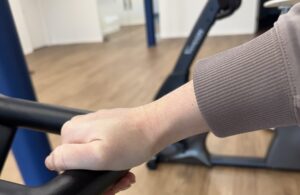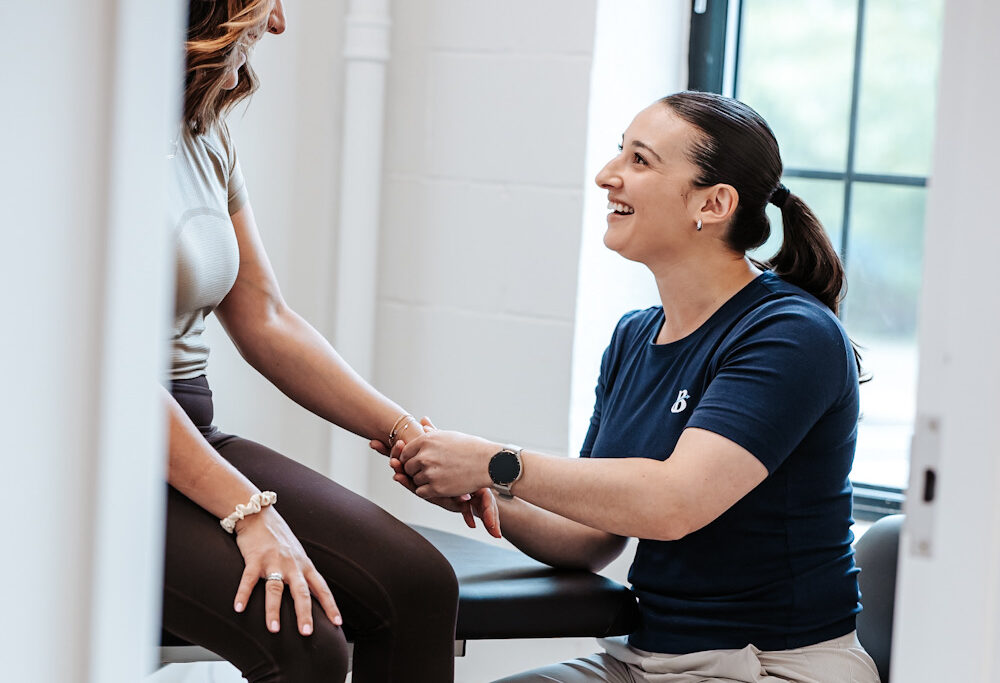If you’re a mom experiencing sharp pain along the thumb side of your wrist, especially when breastfeeding or holding your baby, you’re not alone! This condition often called “mom wrist” is medically known as de Quervain’s tenosynovitis. In this blog, we’ll discuss what this is, why it happens, and how to treat it!
What is “mom wrist” / de Quervain’s Tenosynovitis?
De Quervain’s Tenosynovitis is a condition where the tendons of the thumb, and the sheath surrounding them, become irritated.
These tendons are called Extensor Pollicis Brevis and Abductor Pollicis Longus and their main function is to extend and abduct the thumb (move it away from your palm and away from your other fingers).
To find these tendons, you can move your thumb into those positions (back away from your palm and out away from your pointer finger). You will see a small gap at the base of your thumb. This is called the “anatomical snuff box.” At the bottom portion of the anatomical snuff box, you’ll find your EPB and AbPL tendons, the tendons responsible for “mom wrist”!

Why is it called “mom wrist”?
Women are 6x more likely to experience de Quervain’s Tenosynovitis than men, and 40% of all cases of De Quervain’s Tenosynovitis occur in women who are recently postpartum (giving rise to the nickname, “mom wrist”)!
Increased risk of developing mom wrist can be associated with women experiencing their first pregnancy, pregnancies that last > 40 weeks, and potentially women with thyroid disorders.
Why does “mom wrist” / de Quervain’s Tenosynovitis happen?
Mom wrist can be caused by mechanical overuse of the thumb tendons we discussed earlier. Overuse tends to occur when the muscles are being asked to perform an action very repetitively.
Examples of repetitive movements utilizing the wrist/hand during the early postpartum period can look like:
- Supporting the baby’s head
- Breastfeeding
- Changing diapers
- Lifting the baby
- Lifting a carseat
- Pushing a stroller
- And more!
A lot of these movements tend to place the wrist in a bent or twisted position. Using your hand, wrist, and forearm muscles in these twisty positions can be really tough for the muscles, and lead to irritation over time!
What can I do about my wrist pain?
See a physical therapist! Every individual’s symptoms may present differently and each individual has different tasks they want to accomplish, so it is always best to get personalized evaluations and treatment for pain.
Physical therapy for mom wrist / de Quervain’s tenosynovitis might include:
1. Activity Modification
At BEYOND PT, your physical therapist will observe some of the movements that lead to pain in your wrist, and work with you to make temporary adjustments. For example, if your wrist hurts during breastfeeding, we can work with you on supporting your wrist better or discussing different breastfeeding positions.
A simple trick you can try is assessing if your wrist is in a twisty position during the activity that hurts, and try to accomplish that task with a more neutral position. If your wrist hurts while pushing the stroller (photo A), try putting your wrist in a neutral position (Photo B) and see if this alleviates some of your symptoms.

Photo A

Photo B
2. Soft tissue mobilization to the tendons of the thumb
Your physical therapist may massage the tendons shown in the photo above to decrease pain in the area. Typically, this can be prescribed to do at home for 2 mins/day with lotion.
3. Joint mobilization to the wrist
Your PT may perform joint mobilizations to the joints of the wrist if needed. If the joints of the wrist are stiff or inflexible into any direction, this may be limiting your ability to perform certain tasks, and making the muscles work too hard!
4. Mobility and Strength Program for the hand, wrist, and forearm
Your PT will help you build a strength & mobility program in non-painful positions. Improving your muscle length and strength helps the tendons to heal and then improve, so you can accomplish all of your desired tasks with ease.
These may include forearm stretching, thumb tendon gliding, grip strength training in neutral positions (progressing to the positions that are currently painful), and more!
5. Possible Referral
If your symptoms are not improving right away, your PT may suggest referral to your PCP and/or an orthopedic specialist. There is research showing that temporary splinting of the thumb and corticosteroid injection can be helpful treatments in reducing pain.
Where do I start?
The first step would be scheduling an appointment with your physical therapist. If you’d like to see one of our Doctors, click here to schedule a free 15-minute introduction call with us.
—
Sources:
- doi:10.1001/jamanetworkopen.2023.37001
- 10.1111/1440-1630.70014
- https://doi.org/10.1177/15589447221150524
- PMID: 37141474
- 10.1177/15589447221150524
- https://meddocsonline.org/journal-of-orthopedics-and-muscular-system/epidemiological-study-of-de-quervains-tenosynovitis-in-postpartum-women.pdf?utm_source=chatgpt.com
- https://doi.org/10.52965/001c.36911


